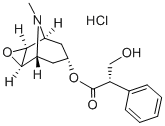All AbMole products are for research use only, cannot be used for human consumption.

For this product's availability, delivery time and price, please email [email protected] directly or click the "Inquiry Now" button below.
Scopolamine hydrochloride is a non-selective and high affinity (≤1 nM) muscarinic antagonist that is used for the prevention of post-operative nausea and vomiting. Scopolamine readily passes the blood brain barrier. Scopolamine also reversibly inhibits 5-HT3 receptor-responses with an IC50 of 2.09 μM.
| Molecular Weight | 339.81 |
| Formula | C17H22ClNO4 |
| CAS Number | 55-16-3 |
| Storage |
Powder -20°C 3 years ; 4°C 2 years In solvent -80°C 6 months ; -20°C 1 month |
[3] T C Hain et al. Arch Otolaryngol Head Neck Surg. Mal de debarquement
[4] D J Greenblatt et al. JAMA. Intramuscular injection-site complications
| Related Animal Modeling Products |
|---|
| Sodium Thioglycolate
Sodium thioglycolate acts as reducing agent and is suitable for anaerobic and microaerophilic bacterial growth. Sodium thioglycolate is a commonly used reagent for bacteriological research to maintain reducing conditions in media. Thioglycolate can also protect enzymes against inactivation by maintaining protein thiol groups in the reduced state. Thioglycolate medium is frequently used in inflammation research to elicit a neutrophil and macrophage response in vivo. |
| Vancomycin-d10 2TFA salt
Vancomycin-d10 2TFA salt |
| Acetic acid-d4
Acetic acid-d4 |
| Myosin H Chain Fragment, mouse acetate
Myosin H Chain Fragment, mouse acetate salt is a fragment of the α-Myosin heavy chain peptide. Myosin H Chain Fragment can be used to induce experimental autoimmune myocarditis (EAM) mouse model. |
| Myosin H Chain Fragment, mouse
Myosin H Chain Fragment, mouse is a fragment of the α-Myosin heavy chain peptide. Myosin H Chain Fragment can be used to induce experimental autoimmune myocarditis (EAM) mouse model. |
All AbMole products are for research use only, cannot be used for human consumption or veterinary use. We do not provide products or services to individuals. Please comply with the intended use and do not use AbMole products for any other purpose.


Products are for research use only. Not for human use. We do not sell to patients.
© Copyright 2010-2024 AbMole BioScience. All Rights Reserved.
